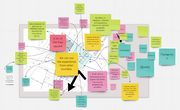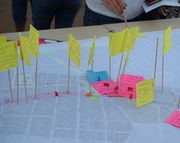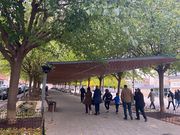Category:1 What is a participatory process
From V-Global Wiki
What is participation?
Participation, in general, is a structured methodology involving a community/group of people in a specific collective practice or decision-making. Participation can make a process inclusive and democratic It can make different voices and needs to be heard The participatory projects vary regarding objectives, methods, tools, scale, subjects, goals, and expected results.
Community participation, in general, and participatory design, specifically, are terms that, although broadly used, are not to this day fully defined. There are many ways in which participation can be implemented, and the projects of participatory design vary a lot in terms of their objectives, methods, tools, and results.
Over the past decade, there has been a real shift towards more democratic and participatory decision-making processes. Among other institutions, the European Union (EU) promotes and develops participatory governance by meaningfully involving relevant stakeholders in all phases of the policy cycle, from identifying the problem to policy evaluation and recognising the added value of such engagement. This “participatory turn” is based on the consultation/participation methods of various citizens and social groups that have developed in the last decades. Yet, the process has been greatly enhanced by the explosion of new technologies and social networking tools over the last decade.
Nevertheless, the idea of participation in planning and designing space started way back, in the 1950s and 1960s, following a discussion on community engagement and the activation of the city dwellers. This period as Marcus B. Lane (2005) puts it in his book “Public Participation in Planning: an intellectual history”, marks also “perhaps the single most important ‘revolution’ in planning thought occurred in the late 1950s and 1960s”. According to him, it was at that time when, first in the US and then in Britain, systems or synoptic planning usurped blueprint planning. This - in his understanding - made geographers and urban planners able to work on another scale, which was impossible until then. It gave them the opportunity to approach the planning process from different points of view, using different data and being able to include other opinions and ideas.
After some years the idea of the citizen’s participation in decision making and planning had gained important recognition. At that point, around 1970, criticism appeared on the field. An important voice was that of Arnstein (1969), who provocatively argued that “the idea of citizen participation is a little like eating spinach: no one is against it in principle because it is good for you” (Arnstein 1969, p. 216). What Arnstein tried to do was to deliver a serious critique on the citizen participation as it was implemented in many urban planning programmes. In her opinion in many of those programmes, the people in charge, the policy makers, or the planners, did not really seek for public participation, but only for the public consensus that a pretence of participation would bring. Her main point was that for participation to be meaningful, there should also be a redistribution of power.
In the last few years, many have tried to give the participation term a more comprehensive definition. One example is that of Giaoutzi and Stratigea (2011), who consider participatory planning as a "democratic process of lifelong learning, in which participants gain knowledge about themselves but also the values and views of other participants".
According to Giaoutzi and Stratigea (2011), the participatory approaches in planning answer mainly to the needs of:
- Conflict management between the evolution of technology/science and society that has been developed since the midst 20th century.
- Management of environmental problems, especially from the 1960s and onwards.
The meaning of participation
A participatory activity/workshop/design is a methodology in which:
- The process is structured according to the basic objectives and activities of participation.
- The facilitators and participants collaborate in order to make a decision or develop a collective result on a problem/subject.
- A combination of specific techniques and tools is implemented.
The fields of participation
Levels of participation of various stakeholders in different fields:
- Public space discourse and conceptualization
- Urban planning and design
- Strategic planning
- Culture and art
- Education
- Virtual Field Trip creation
- Collective mapping
- Collective identification of any problem and solution proposal
This category currently contains no pages or media.


